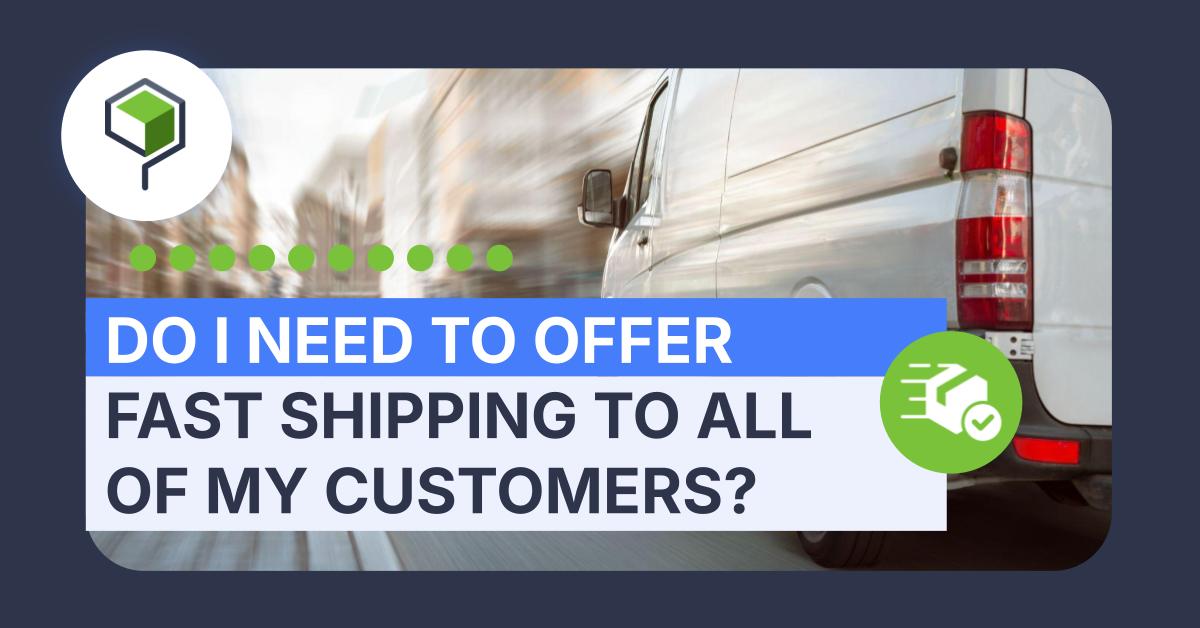
When an online order can be placed in just a few clicks, it’s easy for customers to forget what needs to happen behind the scenes to get their package delivered. Services like overnight shipping and same-day delivery are not only expensive – they’re also very demanding operationally for ecommerce brands.
When it feels like all online shoppers are expecting you to compete with the likes of Amazon, the pressure to offer fast shipping can feel immense. But is fast shipping really necessary in ecommerce fulfillment? And how do you know whether it’s the right investment for your business?
We’re going to answer those questions and more in this blog!
Do ecommerce customers really want fast shipping?
We often hear that ‘ASAP’ is the only shipping service worth offering in ecommerce. But is this backed up by evidence? Let’s take a look.
According to shipping services provider Popout Inc., fewer online shoppers want same-day or next-day delivery compared with 2023, at 10% compared with 18%. Similarly, DigitalCommerce360 found that next-day shipping and same-day delivery was preferred at just 23% and 17% respectively, compared to 82% that wanted free shipping.
It’s clear that for many customers, shipping cost is a much bigger priority than speed. If a free shipping option can guarantee delivery within just a few days, this is often more desirable than a same-day delivery method where the customer has to foot the entire bill.
Moreover, the growing popularity of services like unscheduled delivery – where customers aren’t bound to an evening or morning delivery time – indicates that flexibility is an increasingly important consideration now that COVID-19 stay-at-home orders are over. If receiving an order within a few hours demands that a customer be home at a certain time to receive it, this lack of inconvenience edges out many fast shipping options in favor of slower services.
In sum, fast delivery in ecommerce might not be the sale-maker (or the deal-breaker) that is often assumed. This should come as a relief, considering the difficulties that ecommerce businesses face when implementing expedited shipping options.
The challenges of offering rapid delivery
Speed of fulfillment
Once a package has shipped, whether the delivery time is met is solely in the hands of the shipping carrier. But there’s an entire stage before shipment that often gets forgotten; the order fulfillment process.
Every service level has a cutoff time that a package needs to be shipped to guarantee on-time delivery. The faster the delivery method, the less time your business has to process, pick, and pack an order for shipment.
For example, if you want to offer a same-day shipping and delivery service, orders may have to be in the hands of the carrier as early as 11am; this leaves only a few hours to complete the entire order fulfillment process. Overnight shipping services will carry a later cutoff time but still demand highly streamlined fulfillment to meet the delivery date promised, depending on factors like delivery area, shipping carrier, package size, and more.
In sum, fast delivery simply isn’t going to happen unless your business has its ducks in a row where order fulfillment is concerned. Even minor delays in processing orders or picking items can translate to orders missing their afternoon delivery slot – and very unhappy customers.
Shipping costs
It might be pointing out the obvious, but shipping costs tend to be the biggest barrier preventing ecommerce businesses from offering overnight shipping or next-day delivery to their customers.
Even when minimizing the number of shipping zones as much as possible or practicing effective cartonization for smaller package dimensions, shipping rates for rapid delivery speed can prove simply too much, especially for small ecommerce businesses that already have narrow profit margins.
Offering the same delivery options to all customers
If your customers are spread out across the country or internationally, it might not be possible to offer the same delivery speed to all customers. For example, guaranteeing same-day delivery to customers who are more than 10 miles away from your facility is a tall order, even with a streamlined same-day fulfillment strategy. Likewise, cost-effective ground shipping services won’t be available to customers in Hawaii or Alaska.
Shifting away from so-called ‘standard delivery’ (whatever shipment method this may be on the backend of your system) requires much more granular shipping method mapping to ensure that your checkout is populated with the right options for each customer. This requires considering information such as order value, delivery address, package weight, and the SKUs present in an order. If not implemented properly, customers could end up selecting shipping options that aren’t available to them, resulting in delayed delivery.
5 Questions to ask before adding a rapid delivery service
Can I afford faster delivery?
Before looking at anything else, you need to figure out whether express shipments are actually on the table for business, and what might be affected by your business choosing to focus resources in this area. This means weighing up the potential gains of faster delivery against the expenses required to offer it via your online store.
For example, the gains could be a strong competitive differentiator, attracting more customers, or increasing average order value. Costs include not just the shipping costs themselves, but anything else such as operational upgrades or higher labor costs needed to implement it. This also needs to be offset against risks like delayed delivery, higher operational complexity, or increased customer support burdens.
Considering these factors in your analysis will help you to determine whether fast shipping options are realistic for your business and whether there is enough benefit to justify the cost.
What do my customers want?
Consumer surveys might indicate that customers are interested in faster delivery options. But what matters is what your customers want. After all, they’re the ones who are buying from you!
So, before you start making significant operational investments to make services like overnight delivery possible, check that this aligns with the shipping options that your customers want most. If low cost is a bigger priority, then it’s unlikely they’ll be interested in express shipping anyway – making it a wasted investment when your shipping strategy should be focused elsewhere.
Am I offering enough shipping options?
Fast shipping is not the be-all, end-all – neither is free shipping, flat-rate shipping, or any one shipping option, for that matter.
The truth is there’s no single delivery method that will adequately capture all of your customer’s needs. Some online shoppers will happily shell out for expedited delivery, while others will stick with the free shipping option that doesn’t add extra dollars to their order.
In ecommerce, it’s offering choice and flexibility that counts. Offering multiple shipping options through your online store ensures that customers can effectively customize delivery to suit their precise needs, meaning less friction at the checkout.
Will I be able to ship all my inventory using this method?
Not all of your inventory will be suited to express shipping options, whether that’s due to size, weight, or product characteristics that make expedited shipping either too expensive or not available. It’s important to assess your entire inventory to understand which SKUs need to be excluded from certain shipping services. As well as helping you to understand how expensive fast delivery options are likely to be, this also ensures that you don’t end up mistakenly offering express shipping options on any orders where you shouldn’t.
Do I need a reliable logistics partner?
In addition to coordinating the fulfillment process, assessing your inventory, and understanding the risks and benefits of fast shipping, your business also needs to decide what parcel carriers to use and what service levels are appropriate. If you don’t have strong logistics expertise in-house, it’s a good idea to consider partnering with an experienced 3PL who can design the optimal shipping strategy for your business that balances carrier selection with performance and cost.
A 3PL can find you the cheapest overnight shipping options for your inventory with ease, and leverage their shipment volume to give you access to wholesale shipping rates that put less pressure on your bottom line. At ShippingTree, you can access all of these perks – and more. Our intuitive platform also makes it easy to track every shipment and ship orders from the warehouse closest to your customers, so you save money on shipping costs and get orders delivered faster. Pretty neat, right?



